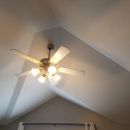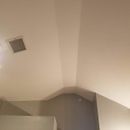How to insulate a vaulted ceiling (non-cathedral) attic floor?
I live in Climate Zone 2, Houston, TX. I am adding insulation to my attic to increase comfort and cut down on A/C. I realize that I need to airseal and preparation before insulation but I am stumped as to how to properly insulate my vaulted ceilings. I live in a 3 story condo. The 3rd floor’s ceiling is half vaulted ceiling, half flat. I can easily blow in insulation to the flat part.
What is the best, non-spray in foam, method to insulate the vaulted ceiling? If I blow in cellulose on top of the small amount of fiberglass that is already there, it is likely to tumble down the slope of the vaulted ceiling (but maybe not, thoughts?). I really want to blow in to get into all the nooks and crannies but it might not be possible. I also think that blow in will require less time than cutting all the batts to size, since the shapes and angles of the ceiling are very abnormal (see pics). However, I’ll go the hard work of the batt route if there is just no way to blow in the cellulose on the sloped vaulted ceiling/attic floor. I was thinking of maybe gently laying a mesh fabric (same thing that they use to insulate with blow-in prior to drywall) to “hold” the cellulose in place, so it won’t shift. This might be the same amount of trouble, though, as cutting the batts. Thoughts and advice?
In summary
1. Climate Zone 2
2. Trying to insulate Vaulted ceiling/attic floor
3. Slope approximately 30-35° (flatter than 45°) (see picture of inside)
4. Current insulation: R-19
5. Desired insulation: R-38
How to insulate the best?
GBA Detail Library
A collection of one thousand construction details organized by climate and house part











Replies
Wow, the someone made some really strange ceiling geometry decisions there.
At those angles, blown cellulose will not reliably stay on the slope, regardless of the presence of fiberglass batts. Same story with blown fiberglass. A quick google search put the maximum slope for either at around 5:12, or about 22 degrees. I doubt it is worth the effort to install netting, though it will depend on how accessible the rafters are from the attic.
One product that might work well for you is spider insulation, which is basically spray fiberglass mixed with glue. GBA has a small article on it here: https://www.greenbuildingadvisor.com/article/getting-to-know-spider-insulation
Otherwise, you might be stuck using batts.
Edit: Found a set of recommendations over at the NREL website:
When using cellulose, stabilized product is preferred when available
On roof pitches less than 6/12, loose fill cellulose can be used; on roof pitches greater than 6/12, install non-woven polypropylene netting (webbing) baffles of the same height as the insulation every 6' across slope to prevent the loose fill insulation from sliding downward, or dense pack cellulose above webbing stapled to the bottom (underside) of the rafters
Loose fill fiberglass will only be used on a slope less than or equal to a 6/12 pitch or the slope application approved by the manufacturer, whichever is less (dense packed fiberglass at slopes greater than 6/12 may be used)
Roof cavities will be insulated with loose fill according to manufacturer specifications without gaps, voids, compressions, misalignments, or wind intrusions
Insulation will be installed to prescribed R-value
https://sws.nrel.gov/spec/410031
Very helpful article and link, thank you for this.
I discovered through some calculation that the slope is about 9:12, so quite steep by roof standards. Although, the longest portions are only 8' ascending, so by the netting suggestion of every 6', I would probably just do it once on these vertical assemblies at 4'. By my estimation and this suggestion, it would require at least 3 nets of about 8' total in length at the 4' marker. This does not sound so bad so this might just work.
I will also look at the spider insulation article.
Thank you for this! Very helpful indeed.
I know you mentioned early in your post that you know that you have to air seal first, but I am really curious how your insulation plan dovetails with your air sealing plan?
Peter